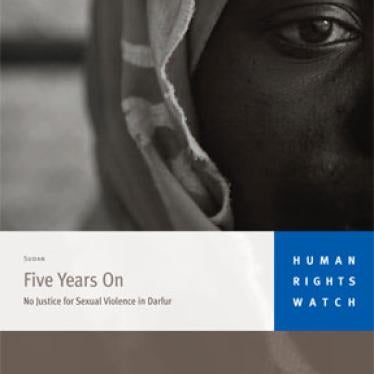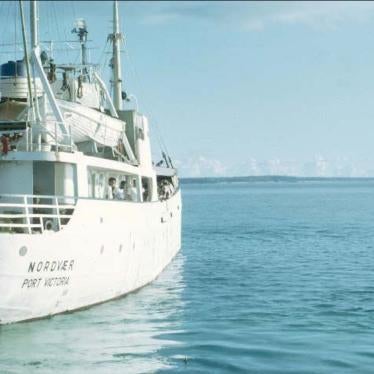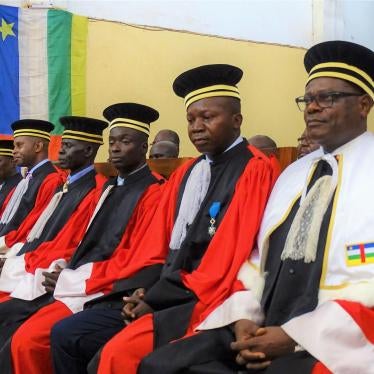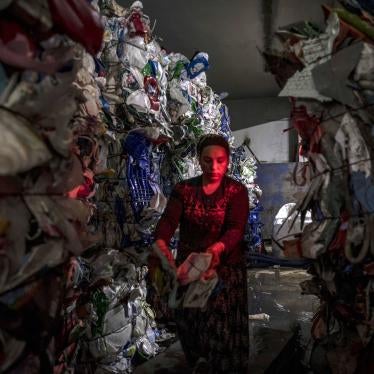What has happened in Darfur?
Since early 2003, Sudanese government forces and militia called “Janjaweed” have been engaged in an armed conflict with rebel groups called the Sudanese Liberation Army/Movement (SLA/SLM) and the Justice and Equality Movement (JEM). As part of its operations against the rebels, government forces waged a systematic campaign of “ethnic cleansing” against civilians who are members of the same ethnic groups as the rebels. Sudanese government forces and the Janjaweed militias burned and destroyed hundreds of villages, caused tens of thousands of civilian deaths, displaced millions of people, and raped and assaulted thousands of women and girls.
As of April 2008, some 2.5 million displaced people live in camps in Darfur and more than 200,000 people have fled to neighboring Chad, where they live in refugee camps. In addition to the people displaced by the conflict, at least 2 million additional people are considered “conflict-affected” by the United Nations (UN) and many need some form of food assistance because the conflict has damaged the local economy, markets, and trade in Darfur.
Rebel allegiances have shifted and split since the conflict began, most notably in November 2005, when the SLA split into two factions, and once again following the signing of the Darfur Peace Agreement (DPA) in May 2006. As of April 2008, there are some two dozen splinter factions of the SLA and JEM.
For a period in early 2005, the number of government attacks on civilians decreased, partly because the majority of targeted villages were already destroyed and their inhabitants displaced from the rural areas. In late 2005, however, the situation dramatically worsened, and deteriorated still further after the May 2006 Darfur Peace Agreement.
Throughout 2006 and 2007 the situation gradually transformed due to the increasing fragmentation and changing allegiances of the parties. As both government and rebel factions jockeyed for position and pursued military gains, violent clashes and outright targeted attacks on civilians continued across Darfur. However, civilians also suffered harassment, beatings and rape even outside the context of large scale attacks, at the hands of government forces, militia, rebels and ex-rebel groups and bandits.
What is happening in Darfur now?
The government of Sudan in 2007 and 2008 continued its bombing campaign, carrying out massive air strikes on civilian areas purportedly under rebel control in all three Darfur states. Government-backed militias have also carried out large scale attacks on the civilian population across Darfur.
In February 2008, government forces and allied militia carried out a series of coordinated attacks on villages in West Darfur, purportedly in response to military gains by JEM in the preceding two months. On February 8, 2008, three villages—Sirba, Silea and Abu Suroj—were attacked in a single day by the Sudanese Air Force with Antonov bombers and helicopter gunships, backed up by Janjaweed militia on horseback. The Janjaweed followed up the bombing with burning, looting, rape and killing. At least 100 civilians died as a result of these attacks, and at least 10 women were raped or sexually assaulted.
In the following weeks, clashes occurred between government forces and JEM and the SLA in the nearby Jebel Mun area. Government forces targeted civilians, some being sought out in their hiding places and shot.
Abuses are also carried out by rebel and ex-rebel groups. Residents of North Darfur have increasingly complained about abuses carried out by forces aligned with former rebel leader Minni Minawi, called the SLA-Minni Minawi, who signed the Darfur Peace Agreement in May 2006. These abuses against civilians, as well as clashes between SLA-Minni Minawi fighters and rebel groups, have also caused substantial displacement, especially of people from Korma and Tawila, to various camps in the area.
Over the past two years, the Janjaweed militia have increasingly been integrated into more “official” government security forces, such as Border Intelligence, Popular Defence Forces and Central Reserve Police. However, some militia also have grievances against the government, particularly those whose promised salaries have not been delivered. This has led to some outbreaks of violence, most recently in El Fasher in April 2008 when militia protesting lack of pay attacked the market and other areas, leaving at least 15 people dead. In addition, some militia have switched allegiances to rebel groups, at least for a period. For example, in early 2008, Janjaweed leader Mohamed Hamdan briefly made an alliance with both the SLA and JEM, before reaching a new agreement with the government.
Since January 2007 there has also been an increase in violent clashes between Arab armed groups, particularly in South Darfur, which has left more than 200 people dead and forced thousands to flee.
Who is providing protection for civilians in Darfur?
On July 31, 2007, the United Nations Security Council, with the consent of Sudan, agreed to deploy a peacekeeping force of up to 26,000 international military and police personnel in Darfur. This combined African Union and UN “hybrid” force (UNAMID) formally took over authority from the beleaguered African Union Mission in Sudan (AMIS) on January 1, 2008.
However, because of Sudanese government obstruction, few additional troops were deployed at the transfer of authority, and even by April 2008 the force was barely one third of its authorized strength. The government of Sudan threw up a series of bureaucratic obstructions to the force, including delaying allocating land for bases and the arrival of critical equipment. Khartoum has also insisted that the peacekeeping force be composed primarily of troops from African countries, although there are no equivalent African troops ready to deploy. Other governments have also failed to support the force. UNAMID has been seeking critical units, including 24 helicopters, since July 2007. As of April 2008, only five helicopters had been offered.
Why has the situation in Darfur deteriorated?
One of the key problems is that over the past four years the Sudanese government has continued to follow a policy of supporting ethnic militias, coordinating or tolerating attacks on civilians and permitting serious violations of international law to go unpunished—including attacks on peacekeepers and humanitarian aid workers and their convoys. The continuing conflict and fragmentation of the rebel groups has also contributed to increasing lawlessness in parts of Darfur. This in turn has allowed bandits to flourish and rebels to attack aid convoys and kill civilians. The ceasefire agreement of April 2004 was repeatedly violated by all sides to the conflict, and the DPA’s permanent ceasefire agreement is suffering the same fate.
How does the insecurity affect the humanitarian aid operation?
The deterioration in security, combined with targeted attacks on aid workers, has severely limited humanitarian access to large areas of Darfur. Between January and April 2008 four humanitarian workers were killed in Darfur, and 102 humanitarian vehicles were hijacked, while 29 drivers contracted by World Food Program to deliver food aid were missing as of April 14, 2008. During the same period at least 14 humanitarian premises were attacked by armed persons and four humanitarian compounds were destroyed and looted. At least 100,000 people are currently cut off from humanitarian aid, and many more are accessible only by helicopter.
What is happening in Chad?
Violence in Chad has been escalating since late-2005 as Chadian rebels backed by the Sudanese government established bases in Darfur and began carrying out attacks across the border. The Chadian rebels attacked N’Djamena, the Chadian capital, in February 2008 but were repelled by Chadian government forces.
Darfur rebel groups have long had a presence in eastern Chad, including within refugee camps, which host more than 200,000 refugees from Darfur. The rebel faction JEM is a staunch ally of the Chadian government, acting as a proxy force against Chadian rebel groups in return for safe harbor, material and financial support.
In addition to Chad’s internal conflict, Sudanese Janjaweed militias and allied Chadian militias have been responsible for large-scale attacks against civilians inside Chad, most recently in March 2007, when at least 200 were killed in a village near the border with Sudan. Hundreds more were killed in attacks on more than 70 villages in November 2006.
Inter-communal tensions along the border with Darfur have been inflamed by the militia violence, and also by the Chadian government’s policy of funneling weapons to village-based self-defense forces along ethnic lines. This is apparently an effort to reduce support for Chadian rebel groups that operate in the same zone, and to create a first line of defense against cross-border incursions.
In September 2007 the United Nations Security Council approved a hybrid European Union (EU)/UN civilian protection mission for eastern Chad comprised of EUFOR, a 3,700-strong European Union military force, and MINURCAT, a UN humanitarian operation tasked with training police and improving the judicial system.
What can be done to protect civilians?
In the long term, a fundamental problem is that the Sudanese government continues to pursue policies that target civilians in Darfur, including through its military strategies, such as recruitment and use of abusive militias, and its providing impunity from prosecution to those responsible for crimes in Darfur. International institutions and governments must apply pressure on the Sudanese government to end these policies and practices, including through the application of targeted individual sanctions and other measures. Rebels and ex-rebels also need to be brought under pressure to end their abuses.
Now that the UN Security Council approved the deployment of a UN-AU “hybrid” peacekeeping force, it is up to the international community to ensure the force is properly equipped, deployed, and operates with a robust civilian protection mandate, and that the government of Sudan is not allowed to obstruct its deployment or hinder its operations.
UNAMID is to consist of up to 26,000 military and police peacekeeping personnel. A lesson learned from AMIS is that boots alone will not be enough to ensure UNAMID’s ability to carry out its civilian protection mandate. UNAMID will need to be widely and strategically dispersed throughout Darfur, have strong rapid response capabilities, carry out regular daytime and nighttime patrols, including firewood and market day patrols, employ well-trained and well-resourced policing units, and contain human rights officers whose findings are publicly reported. UNAMID should have a large number of staff who are experts in sexual and gender-based violence, as well as children’s rights. UNAMID should also improve humanitarian access so that aid organizations can provide assistance to populations at risk.
All of this will require substantial resources to support the force, including the provision of critical equipment such as helicopters. However, it will also require the political will to maintain pressure on Khartoum to actively facilitate the deployment of the force.
How does the Sudanese government explain the situation in Darfur?
In the first few years of the conflict, the Sudanese government regularly described the situation in Darfur as “tribal clashes” and consistently refused to acknowledge its responsibility for systematic attacks on civilians. Khartoum has accused international journalists and human rights groups of “fabricating” the Darfur situation, despite the overwhelming evidence of the Sudanese government’s responsibility for the crimes. The government has tried to limit media access to Darfur and has consistently harassed journalists and restricted press freedom in an effort to stop the information flow from Darfur. In 2004 the government detained the Al Jazeera correspondent in Khartoum for several weeks after the news agency transmitted reports about Darfur and in August 2006, several western journalists were arrested in Darfur and turned over to Sudanese intelligence. Although these individuals were later released, in September 2006 the Sudanese government began cracking down on Sudanese media through pre-print censorship and arbitrary arrests, and imposing many bureaucratic restrictions on international journalists. Khartoum continues to massively understate the crisis in Darfur, maintaining that only 9,000 people have been killed in the five years of conflict.
What is the UN Security Council doing about Darfur?
Despite passing more than a dozen resolutions over a period of four years demanding that the Sudanese government take certain steps, including disarming its militias and ceasing attacks on civilians, there has been little united effort by the UN Security Council to ensure these demands are implemented.
The main reason is that the UN Security Council is divided on Sudan because different member states have divergent interests. Russia and China have often supported the Sudanese government because of ideological commitments (non-interference in internal affairs of member states) and both have economic interests in Sudan. China, for instance, imports between 4-7 percent of its oil from Sudan and the Sudan oil project is its most successful international oil development endeavor.
The most recent action taken by the Security Council was its approval of the UN-AU “hybrid” peacekeeping force in July 2007. Two other important steps taken by the Council were the referral of the situation in Darfur to the International Criminal Court (ICC) in The Hague because of crimes against humanity and war crimes in Darfur, and the establishment of a sanctions committee and a panel of experts to investigate individuals who violate the arms embargo, commit abuses of human rights, or impede the peace process. They have to-date only imposed sanctions on four individuals, none of them senior government officials.
What kind of sanctions is the UN imposing on parties in the Darfur conflict?
In December 2005 the UN panel of experts recommended that 17 people, including the Sudanese Minister of Defense, Major-General Abdel Rahim Mohammed Hussein, nine other government officials, two Janjaweed militia leaders and five Darfur rebel commanders, be sanctioned for their role in committing human rights violations and impeding the peace process. In April 2006 the UN Security Council voted for targeted sanctions on four Sudanese individuals: a former Sudanese military commander, a Janjaweed militia leader and two rebel commanders. These sanctions include travel bans and freezing foreign bank accounts and other assets. No active duty or serving Sudanese officials have been placed on the sanctions list. Since the imposition of targeted sanctions against these four fairly low-level individuals a year ago, the UN Sanctions Committee has failed to sanction further individuals due to objections by China, Russia and Qatar.
In September 2007 the Panel of Experts submitted a new report to the UN sanctions committee that described breaches of international humanitarian law and human rights and blatant violations of the arms embargo by all the warring parties. They also reported the Sudanese government’s unlawful use of “UN”-marked planes for military operations and breach of the ban on offensive military overflights, as well as their failure to implement existing sanctions. The Panel’s October 2006 report included another confidential annex of additional names of individuals recommended for targeted sanctions, and the September 2007 report included a public list of names. However, as of April 2008, there has been no action by the UN Security Council to extend sanctions to any of the senior figures responsible for past or recent attacks on civilians.
What is the International Criminal Court doing on Darfur?
The International Criminal Court (ICC) opened an investigation into the situation in Darfur in June 2005. The ICC has the mandate to investigate those individuals most responsible for crimes against humanity, war crimes, genocide and other crimes committed since July 2002 in accordance with the Rome Statute. On April 27, 2007, the ICC’s Pre-Trial Chamber issued arrest warrants for Sudan’s state minister for humanitarian affairs Ahmed Haroun and the Janjaweed militia leader Ali Kosheib for a series of attacks in West Darfur in 2003 and 2004. The Sudanese government has publicly indicated it will not cooperate with the ICC and insists that it will try criminals in Darfur itself. Instead of fulfilling its obligations to hand Ahmed Haroun over to the court, Haroun remains State Minister for Humanitarian Affairs in Darfur, and in September 2007 the government appointed Haroun to co-chair a committee mandated to investigate human rights abuses. The second suspect, Kosheib, was reportedly released from Sudanese jail in October 2007, where he had been held on other charges.
Far from cooperating with the court, in April 2008, Sudan’s UN ambassador Abdel-Mahmood Mohamad called for the ICC’s chief prosecutor, Luis Moreno Ocampo, to be brought before a court for impeding the peace process in Sudan.
What is the Sudanese government doing to prosecute war crimes?
There is no indication that the Sudanese justice system is seriously investigating or prosecuting any of the government officials, militia leaders or other individuals responsible for serious crimes in Darfur. It established the Special Criminal Court on the Events in Darfur in 2005 but has convicted very few persons and no leaders. For more information on the Special Criminal Court, please see the Human Rights Watch report, "Lack of Conviction: The Special Criminal Court on the Events in Darfur."
What are the religious dimensions of the conflict in Darfur?
All of the people in Darfur are Muslim. The Sudanese government and its Janjaweed militias are also Muslim. There have been many incidents, however, of government forces and Janjaweed destroying mosques, looting the contents of mosques, killing imams and others seeking refuge inside mosques and desecrating the Koran while attacking civilian villages. For example, in just one small area of West Darfur, Human Rights Watch documented the destruction of least 62 mosques by Sudanese government forces and militia during attacks in late 2003 and early 2004. There have been many subsequent attacks on mosques in different parts of Darfur.
What are the ethnic divisions in Darfur?
There are many different ethnic groups in Darfur with their own languages and customs. The rebel movements are drawn from three main ethnic groups: the Fur, Zaghawa and Masalit, all of which are considered non-Arab. The Janjaweed militias recruited, armed and trained by the Sudanese government are mainly drawn from several small Arab nomadic tribes who historically have no access to land, many of whom migrated into Darfur from Chad as a result of civil wars in Chad in the 1960s-1980s. Historically these groups coexisted peacefully and settled disputes through mediation of their leaders or the colonial government, with payment of damages for casualties and property damaged or stolen. There was intermarriage between ethnic groups, despite clashes over resources. There are also many larger Arab communities in Darfur who have their own homelands or dars, and have not participated in the conflict, so it is an oversimplification to describe Darfur as an African-Arab conflict.
How are people surviving in Darfur?
Nearly 2.5 million people—more than one third of the population—are now living in displaced persons camps where they are almost entirely dependent on international humanitarian assistance. In many areas they cannot go far from the camps because they continue to be attacked by the militias and women are frequently raped and assaulted when they try to collect firewood or go to market. People cannot return to their homes due to the continuing presence of government-backed militias in the rural areas. Because of the war-caused widespread displacement of subsistence farmers and disruption of trade and nomadic migration routes, the economy of Darfur has been severely disrupted. An additional 2 million people, not displaced, are considered “conflict affected” and many are in need of humanitarian assistance. More than 4 million people in Darfur depend on humanitarian aid in some form.
Hundreds of thousands of people in need are beyond the reach of aid workers due to insecurity and targeted attacks as well as interference from obstructive government officials, both civilian and military.
Why would the Sudanese government organize the Janjaweed militias?
Many of the members of the Sudanese armed forces are from Darfur, so the government may have been reluctant to use those troops in a conflict in their own region. In addition, the government of Sudan has often used ethnic militias as proxy forces, including in southern Sudan and the Nuba Mountains. The use of militias provides the government with “deniability;” it claims that it cannot “control” the militias. There is no evidence, however, that it has actually attempted to do so and there is considerable evidence that militias continue to be paid, armed, organized and directed by army military intelligence and other officers, with assistance from civilian state and national officials. The militias allow the Sudanese government to have a large but inexpensive armed force at its disposal that will serve loyally as a counterinsurgency force, as the militias stand to benefit financially (loot and land) from their participation in the fighting.
Who assists the Sudanese government?
The Sudanese government buys and receives military supplies from several countries, including China, Russia, Belarus, Ukraine and others. Sudan’s government revenues have increased substantially since it began exporting oil in August 1999; government revenue is now estimated to have tripled from 1999 to 2004 and its oil revenue is estimated to be US$3 billion a year. As a result, Sudan has been able to purchase additional attack helicopters, MiG planes, artillery and other war materiel. At the end of the 21-year war in the south of Sudan, after a ceasefire was reached in October 2002, the government of Sudan was also able to shift many of its recently acquired arms to Darfur for use in counter-insurgency operations.
The Sudanese government, throughout the war in southern Sudan and now Darfur, has received high levels of international humanitarian assistance. The World Food Program, for instance, is providing assistance for 6 million people in Sudan, including in Darfur and the south.
Glossary
AMIS—African Union Mission in Sudan
DPA—Darfur Peace Agreement, signed by the Sudanese government, SLA and SLA-Minni Minawi in May 2006
EU—European Union
EUFOR—A European Union military force that, with MINURCAT, forms part of the hybrid EU/UN civilian protection mission for eastern Chad
ICC—International Criminal Court
Janjaweed—Sudanese militia allied with the government
JEM—Justice and Equality Movement, a Sudanese rebel group
MINURCAT—a UN humanitarian operation that, with EUFOR, forms part of the hybrid EU/UN civilian protection mission for eastern Chad
SLA—Sudanese Liberation Army, a Sudanese rebel group
SLA-Minni Minawi—SLA splinter group led by former rebel leader Minni Minawi
SLM—Sudanese Liberation Movement, a Sudanese rebel group
UNAMID—United Nations and African Union “hybrid” peacekeeping force, which took over authority from AMIS on January 1, 2008
Last updated: April 25, 2008








